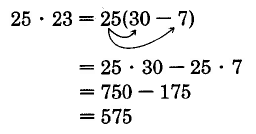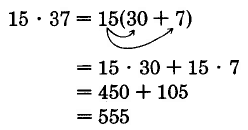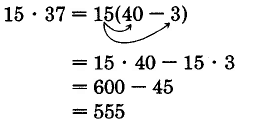8.3: Aritmética mental: uso de la propiedad distributiva
- Page ID
- 116443
Objetivos de aprendizaje
- entender la propiedad distributiva
- ser capaz de obtener el resultado exacto de una multiplicación usando la propiedad distributiva
La propiedad distributiva
Propiedad distributiva
La propiedad distributiva es una característica de los números que implica tanto la suma como la multiplicación. Se usa a menudo en álgebra, y podemos usarlo ahora para obtener resultados exactos para una multiplicación.
Supongamos que deseamos calcular\(3(2 + 5)\). Podemos proceder de cualquiera de dos maneras, una manera que ya conocemos (el orden de las operaciones), y una nueva vía (la propiedad distributiva).
Calcular\(3(2 + 5)\) usando el orden de las operaciones.
\(3(2 + 5)\)
Operar primero dentro de los paréntesis:\(2 + 5 = 7\).
\(3(2 + 5) = 3 \cdot 7\)
Ahora multiplica 3 y 7.
\(3(2 + 5) = 3 \cdot 7 = 21\)
Así,\(3(2 + 5) = 21\).
Calcular\(3(2 + 5)\) usando la propiedad de distribución.
Sabemos que la multiplicación describe la adición repetida. Así,
\(\begin{array} {rclc} {3(2 + 5)} & = & {\underbrace{2 + 5 + 2 + 5 + 2 + 5}_{\text{2 + 5 appears 3 times}}} & {} \\ {} & = & {2 + 2 + 2 + 5 + 5 + 5} & {\text{(by the commutative property of addition)}} \\ {} & = & {3 \cdot 2 + 3 \cdot 5} & {\text{(since multiplication describes repeated addition)}} \\ {} & = & {6 + 15} & {} \\ {} & = & {21} & {} \end{array}\)
Así,\(3(2 + 5) = 21\).
Veamos de nuevo este uso de la propiedad distributiva.
\(3(2 + 5) = \underbrace{2 + 5 + 2 + 5 + 2 + 5}_{2 + 5 appears 3 times}\)
\(3(2 + 5) = \underbrace{2 + 2 + 2}_{2 appears 3 times} + \underbrace{5 + 5 + 5}_{5 appears 3 times}\)

El 3 ha sido distribuido a los 2 y 5.
Esta es la propiedad distributiva. Distribuimos el factor a cada adenda entre paréntesis. La propiedad distributiva funciona tanto para sumas como para diferencias.
Conjunto de Muestras A

Usando el orden de operaciones, obtenemos
\(\begin{array} {rcl} {4(6 + 2)} & = & {4 \cdot 8} \\ {} & = & {32} \end{array}\)
Conjunto de Muestras A

Usando el orden de operaciones, obtenemos
\(\begin{array} {rcl} {8(9 + 6)} & = & {8 \cdot 15} \\ {} & = & {120} \end{array}\)
Conjunto de Muestras A

Conjunto de Muestras A

Conjunto de práctica A
Utilice la propiedad distributiva para calcular cada valor.
\(6(8 + 4)\)
- Contestar
-
\(6 \cdot 8 + 6 \cdot 4 = 48 + 24 = 72\)
Conjunto de práctica A
\(4(4 + 7)\)
- Contestar
-
\(4 \cdot 4 + 4 \cdot 7 = 16 + 28 = 44\)
Conjunto de práctica A
\(8(2 + 9)\)
- Contestar
-
\(8 \cdot 2 + 8 \cdot 9 = 16 + 72 = 88\)
Conjunto de práctica A
\(12(10 + 3)\)
- Contestar
-
\(12 \cdot 10 + 12 \cdot 3 = 120 + 36 = 156\)
Conjunto de práctica A
\(6(11 - 3)\)
- Contestar
-
\(6 \cdot 11 - 6 \cdot 3 = 66 - 18 = 48\)
Conjunto de práctica A
\(8(9 - 7)\)
- Contestar
-
\(8 \cdot 9 - 8 \cdot 7 = 72 - 56 = 16\)
Conjunto de práctica A
\(15(30 - 8)\)
- Contestar
-
\(15 \cdot 30 - 15 \cdot 8 = 450 - 120 = 330\)
Estimación usando la propiedad distributiva
Podemos utilizar la propiedad distributiva para obtener resultados exactos para productos como\(25 \cdot 23\). La propiedad distributiva funciona mejor para productos cuando uno de los factores termina en 0 o 5. Restringiremos nuestra atención únicamente a dichos productos.
Conjunto de Muestras B
Utilice la propiedad distributiva para calcular cada valor.
\(25 \cdot 23\)
Solución
Observe eso\(23 = 20 + 3\). Ahora escribimos

Por lo tanto,\(25 \cdot 23 = 575\)
Podríamos haber procedido escribiendo 23 como\(30 - 7\).

Conjunto de Muestras B
\(15 \cdot 37\)
Solución
Observe eso\(37 = 30 + 7\). Ahora escribimos

Por lo tanto,\(15 \cdot 37 = 555\)
Podríamos haber procedido escribiendo 37 como\(40 - 3\).

Conjunto de Muestras B
\(15 \cdot 86\)
Solución
Observe eso\(86 = 80 + 6\). Ahora escribimos

Podríamos haber procedido escribiendo 86 como\(90 - 4\).

Set de práctica B
Utilice la propiedad distributiva para calcular cada valor.
\(25 \cdot 12\)
- Contestar
-
\(25(10 + 2) = 25 \cdot 10 + 25 \cdot 2 = 250 + 50 = 300\)
Set de práctica B
\(35 \cdot 14\)
- Contestar
-
\(35(10 + 4) = 35 \cdot 10 + 35 \cdot 4 = 350 + 140 = 490\)
Set de práctica B
\(80 \cdot 58\)
- Contestar
-
\(80(50 + 8) = 80 \cdot 50 + 80 \cdot 8 = 4,000 + 640 = 4,640\)
Set de práctica B
\(65 \cdot 62\)
- Contestar
-
\(65(60 + 2) = 65 \cdot 60 + 65 \cdot 2 = 3,900 + 130 = 4,030\)
Ejercicios
Utilice la propiedad distributiva para calcular cada producto.
Ejercicio\(\PageIndex{1}\)
\(15 \cdot 13\)
- Contestar
-
\(15 (10 + 3) = 150 + 45 = 195\)
Ejercicio\(\PageIndex{2}\)
\(15 \cdot 14\)
Ejercicio\(\PageIndex{3}\)
\(25 \cdot 11\)
- Contestar
-
\(25 (10 + 1) = 250 + 25 = 275\)
Ejercicio\(\PageIndex{4}\)
\(25 \cdot 16\)
Ejercicio\(\PageIndex{5}\)
\(15 \cdot 16\)
- Contestar
-
\(15 (20 - 4) = 300 - 60 = 240\)
Ejercicio\(\PageIndex{6}\)
\(35 \cdot 12\)
Ejercicio\(\PageIndex{7}\)
\(45 \cdot 83\)
- Contestar
-
\(45 (80 + 3) = 3600 + 135 = 3735\)
Ejercicio\(\PageIndex{8}\)
\(45 \cdot 38\)
Ejercicio\(\PageIndex{9}\)
\(25 \cdot 38\)
- Contestar
-
\(25 (40 - 2) = 1,000 - 50 = 950\)
Ejercicio\(\PageIndex{10}\)
\(25 \cdot 96\)
Ejercicio\(\PageIndex{11}\)
\(75 \cdot 14\)
- Contestar
-
\(75 (10 + 4) = 750 + 300 = 1,050\)
Ejercicio\(\PageIndex{12}\)
\(85 \cdot 34\)
Ejercicio\(\PageIndex{13}\)
\(65 \cdot 26\)
- Contestar
-
\(65 (20 + 6) = 1,300 + 390 = 1,690\)o\(65(30 - 4) = 1,950 - 260 = 1,690\)
Ejercicio\(\PageIndex{14}\)
\(55 \cdot 51\)
Ejercicio\(\PageIndex{15}\)
\(15 \cdot 107\)
- Contestar
-
\(15 (100 + 7) = 1,500 + 105 = 1,605\)
Ejercicio\(\PageIndex{16}\)
\(25 \cdot 208\)
Ejercicio\(\PageIndex{17}\)
\(35 \cdot 402\)
- Contestar
-
\(35 (400 + 2) = 14,000 + 70 = 14,070\)
Ejercicio\(\PageIndex{18}\)
\(85 \cdot 110\)
Ejercicio\(\PageIndex{19}\)
\(95 \cdot 12\)
- Contestar
-
\(95 (10 + 2) = 950 + 190 = 1,140\)
Ejercicio\(\PageIndex{20}\)
\(65 \cdot 40\)
Ejercicio\(\PageIndex{21}\)
\(80 \cdot 32\)
- Contestar
-
\(80 (30 + 2) = 2,400 + 160 = 2,560\)
Ejercicio\(\PageIndex{22}\)
\(30 \cdot 47\)
Ejercicio\(\PageIndex{23}\)
\(50 \cdot 63\)
- Contestar
-
\(50 (60 + 3) = 3,000 + 150 = 3,150\)
Ejercicio\(\PageIndex{24}\)
\(90 \cdot 78\)
Ejercicio\(\PageIndex{25}\)
\(40 \cdot 89\)
- Contestar
-
\(40 (90 - 1) = 3,600 - 40 = 3,560\)
Ejercicios para la revisión
Ejercicio\(\PageIndex{26}\)
Encuentra el mayor factor común de 360 y 3,780.
Ejercicio\(\PageIndex{27}\)
Reducir\(\dfrac{594}{5,148}\) a los términos más bajos.
- Contestar
-
\(\dfrac{3}{26}\)
Ejercicio\(\PageIndex{28}\)
\(1\dfrac{5}{9}\)de\(2 \dfrac{4}{7}\) es ¿qué número?
Ejercicio\(\PageIndex{29}\)
Resuelve la proporción:\(\dfrac{7}{15} = \dfrac{x}{90}\)
- Contestar
-
\(x = 42\)
Ejercicio\(\PageIndex{30}\)
Utilice el método de agrupación para estimar la suma:\(88 + 106 + 91 + 114\).


